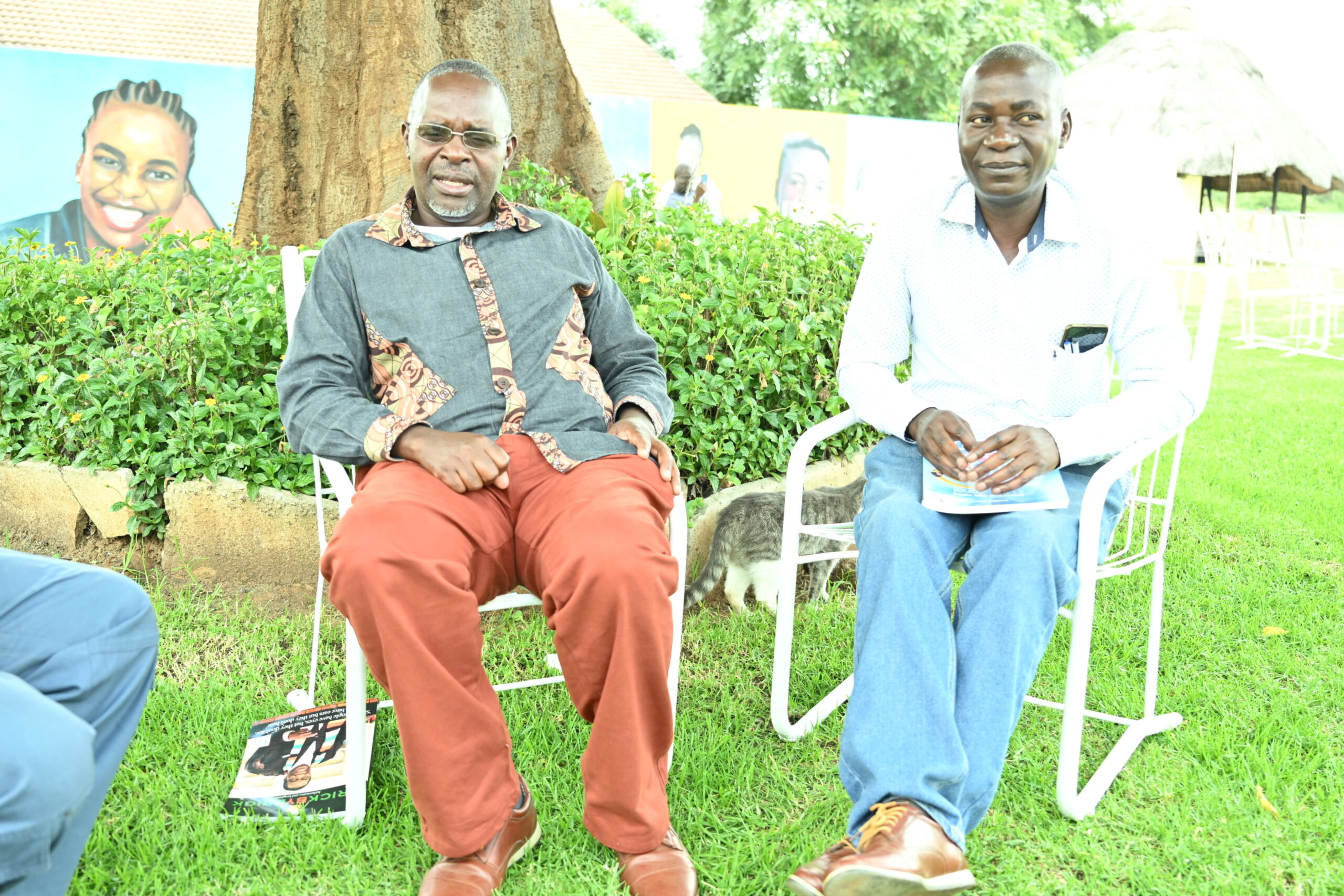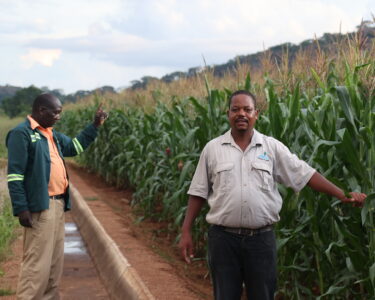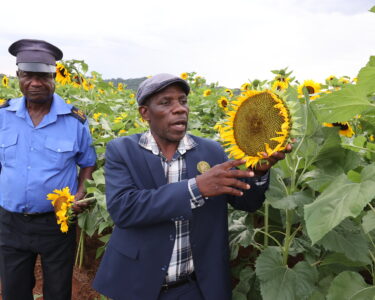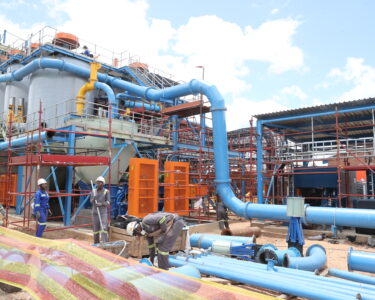The Midlands Province has drawn up a comprehensive Provincial Economic Development Plan (PEDP) in which it articulates its achievements, challenges, dreams and aspirations. It’s a very elaborate and quite insightful document and the temptation is to pluck stories on the province from this plan and congratulate oneself for a job well-done. But this is not our modus operandi at the Brick by Brick magazine.
Naturally, our intrepid Editor-in-Chief Munyaradzi Huni opted to go beyond the blueprint by engaging one-on-one with the Secretary for Provincial Affairs and Devolution in the Midlands Province, Abiot Maronge, and the province’s Director for Economic Affairs and Investment, Kosheni Mtisi, to get the real story behind the economic plan.
According to the two officials, the Midlands is the richest of Zimbabwe’s 10 provinces, hence its reputation as “The Resource Centre of Zimbabwe”. But there appears to be a mismatch between the province’s purported wealth and its citizens’ livelihoods. Why is this so, Munyaradzi Huni sought to find out from his hosts. Read on . . .
Maronge got the ball rolling: “On the economic front, the Midlands Province is, to us, the richest province in the country. We are the richest province in the sense that if you look at the resource potential that we are yet to exploit, we have no doubt that we are at the top. What we need to do is to make sure that the resources are fully exploited. That is what we are working on as we promote investment into the province.
“The province is divided into eight administrative districts and in all them you will see abundance in terms of natural resources. We have one of the biggest universities in the country — the Midlands State University (MSU). In terms of agriculture, the Midlands Province is very active in wildlife management, livestock, cotton and grain production, particularly in Kwekwe. As for cotton, the province produces not less than 50% of Zimbabwe’s cotton, commonly referred to as the ‘white gold’. Gokwe North and Gokwe South stand out in this regard.
“Our rich mineral endowments are second to none. We have 12 high-value minerals ranging from gold, platinum, chrome, diamonds, lithium and a number of other strategic minerals.
“We are the country’s biggest chrome producer. We have moved a step further by value-adding the chrome into ferrochrome. Kwekwe-based Zimasco leads the way in ferrochrome production. However, there also a number of smaller ferrochrome companies based in Gweru. Zvishavane is home to Murowa Diamonds. Mberengwa has vast deposits of lithium, the ‘new oil’, which is attracting considerable interest across the world. In addition, the largest portion of the Great Dyke is found in the Midlands Province.
“In the last three to four years, we have seen quite a lot happening on the economic front. We have Dinson Iron and Steel Company (Disco), which is setting up what is touted as Africa’s largest steel plant at Manhize in the Chirumhanzu area. The company now employs close to 1 000 people, notwithstanding that it has been existence for such a short time. The infrastructural development taking place there is hard to put in words.

“All told, the Manhize Project is shared by three provinces. Although the plant is located in the Midlands Province most of the mining is currently taking place in Mashonaland East Province while neighbouring Mashonaland West Province boasts vast iron ore deposits, the main raw material from which steel is produced.”
Mtisi echoed Mtisi’s sentiments: “We are easily the richest province in the country. That is not debatable.
“We have new players who are coming up in the value chain while some of the existing players are expanding their capacity. For example, Murowa Diamonds has acquired new state-of-the-art equipment. The same applies to Mimosa, who are also expanding their plant to increase the mine’s lifespan as well as boost production. After several years on the periphery of economic activity, accompanied by deterioration of plant equipment, quite a number of companies are retooling, expanding and acquiring the latest mining equipment.

“The Midlands Province is also attracting new economic players in line with national aspirations as enshrined in Vision 2030. A good example is Intrachem, which produces mining explosives and is expected to contribute significantly to the US$12 billion mining industry target. I can go on and on, but to cut a long and exciting story short, the Midlands Province is indeed ‘The Resource Centre of Zimbabwe’.”
Murowa Diamonds, Mimosa, Disco, Zimasco are among the Midlands Province’s undoubted success stories. But lurking in the shadows is the plight of former Ziscosteel workers, who are still fighting to get their terminal benefits. The burning question the writer posed to the Midlands duo of Maronge and Mtisi was whether the former steel-making giant will rise again in the wake of the numerous false starts. Under the First Republic, efforts to revive Ziscosteel failed to yield any tangible results as the potential investors — Essar Holdings of Mauritius and R & F Construction Company of China – developed cold feet at the last minute. I thought the mere mention of the name Ziscosteel would send my two interviewees scampering for cover, but how wrong I was!
Maronge was unshaken. “Yes, there were challenges in attempts to revive Ziscosteel in the past, but we believe that the new investor, Kuvimba Mining House, has what it takes to bring back Ziscosteel’s glory days. Kuvimba Mining House is a local company that has done very well elsewhere and we are confident they will deliver. As President Mnangagwa always says, nyika inovakwa nevene vayo. As an indigenous company, Kuvimba Mining House will surely deliver because it has the motivation and passion to ensure that Ziscosteel enjoys a new lease of life.
“We are really excited about the developments at Ziscosteel. We are likely to see the fortunes of Redcliff in particular and Kwekwe in general being revived. As you know, Ziscosteel was a major player in the province, employing thousands of people and promoting dozens of downstream companies. The majority of these smaller companies collapsed in the wake of Ziscosteel’s demise, but I see most of them coming back to life.
“Even Redcliff Municipality has been struggling in the wake of Ziscosteel’s misfortunes. But we expect things to change for the better. Nyika yava kuvakwa nevene vayo and so we are very, very confident that Ziscosteel will soon come back to life.”
The Minister of Industry and Commerce, Dr Sekai Nzenza, appears to share Maronge’s confidence. This is what she had to say during an impromptu visit to Ziscosteel in April last year: “This is now a different story with the new government led by President Mnangagwa. His mantra is production and production; and the resuscitation of Ziscosteel is one of this government’s top priorities.”
Then there is Bata Shoe Company. Once upon a time, the show manufacturing company was synonymous with Gweru, the Midlands capital, but appears to have lost its step somewhere along the way. Unlike Ziscosteel, Bata has not completely shut shop but its fortunes have taken a dip over the years. The writer asked the Midlands Province’s Director for Economic Affairs and Investment (Mtisi) whether it was possible to rewind Bata’s clock back to the early 1990s when the company was a household name in the footwear industry.
Like his comrade-in-arms Maronge, Mtisi was equally upbeat: “With regards to Bata Shoe Company, there is new capital injection into that company and the people of Gweru are really excited. We are happy because we are seeing some very positive developments at Bata. They are bringing in new equipment to scale up production. Bata has now expanded its footwear range to include safety shoes and gumboots. The export market is also looking good, with Bata shoes finding their way to Eastern African countries like Rwanda. The prospects there are quite bright.”
The burning questions out of the way, it was now time for the Midlands duo to unpack the Midlands Provincial Economic Development Plan (MPEDP).
“The MPEDP is the tool we are using to market the province. For example, we are using it to forge twinning arrangements with cities in China, Russia and Namibia. We want to market our province so as to attract investments from all over the world,” says Maronge.
“The major task at hand is to ensure that the Midlands Province’s potential is fully exploited. The major area of focus going forward is investment attraction and promotion. We have to lay the foundation for the sustained revival of economic activities in the province,” he said.
It’s obvious Maronge was not engaging in cheap bar talk when he spoke glowing about the Midlands being the destination of choice for global investors seeking their own version of the legendary El Dorado. Less than a month ago, provincial and devolution minister Mavima played host to a Russian delegation led by the Minister of Foreign Economic Relations of the Sverdlovsk Region of the Russian Federation, Yarin Vyacheslav, which was in the country to explore areas of cooperation in the mining sector.
The delegation held discussions with Minister Mavima on plans to twin the Midlands Province with Sverdlovsk. “Our aim is to put in place a twinning arrangement between Sverdlovsk and the Midlands Province for the exchange of ideas and investment opportunities which we seem to have in abundance,” Minister Mavima told the media afterwards.
Back to Maronge, who is obviously alive to the fact that investment is not a one-way street: “As a province, we also need to upgrade and modernise our infrastructure. We are exploring ways to value-add our primary products in the medium term. At the moment, we are exporting our cotton in its raw form, but we want that cotton and its by-products to be value-added on-site in line with the proclamation by President Mnangagwa to promote rural industrialisation. In this respect, we are going to work with local companies to establish textile and ancillary businesses in Gokwe,” the provincial permanent secretary said.
But why a textile manufacturing company in Gokwe when efforts are already underway to revive the David Whitehead Textiles plant in Kwekwe, Brick by Brick wanted to know?
Maronge was adamant that Gokwe, as the country’s biggest cotton producer, deserved its own textile manufacturing company. “Given that as a province, we are producing the bulk of the cotton which is then shipped to other provinces and the export market, we are determined to establish cotton-based businesses in the various cotton-growing areas. It may not necessarily be about textile manufacturing per se, as there are alternatives like oil pressing and stockfeed manufacturing. But we cannot rule out textile manufacturing completely because it is a lucrative business. Admittedly, we will be competing with a long-established giant [David Whitehead Textiles] in Chegutu, but I am convinced that a lot more can be done in our province.
“We are also going to work hard to revive the leather industry. There are millions of animals [both domestic and wildlife] in the Midlands which will provide an excellent base for us to revive our dormant leather industry. Again, we will be focusing on establishing rural-based industries in outlying areas like Mberengwa and Zvishavane, among others.
“Under the MPEDP, irrigation is also going to be a key focus area. Government is already funding a number of irrigation schemes in Gokwe South and Zvishavane. Construction is currently taking place at Vungu Dam in Gweru. When complete, it will provide us with the water we need to expand irrigation schemes in Lower Gweru. In line with the government’s economic growth strategy, we want to ensure value addition of crops cultivated at the irrigation schemes. As you know, as long as people have water, they will produce more.”
Mtisi chimes in: “There will also be emphasis on creating aggregation centres at most of the irrigation schemes so that value addition can be done on-site. In this regard, we will establish synergies with the Ministry of Agriculture through ARDA [Agricultural and Rural Development Authority].
“We are also going to embark on a massive investment drive to revive some the Midlands’ distressed companies. The majority of these companies will obviously need new equipment and the latest technology. This explains why the MPEDP is putting emphasis on retooling. I am quite confident that in five years’ time, all things being equal, the Midlands Province should be contributing significantly to the national GDP.”
However, Mtisi was quick to add that there were some dark clouds on the horizon. “Like any other developing country, the resources at our disposal are limited. They will never be enough. This has been a perennial challenge in our attempts to industrialise and modernise the Midlands Province. This is why infrastructure development remains a top priority.
“Because of limited funding, we are forced to prioritise to make the best use of scarce resources. This has been exacerbated by the imposition of illegal sanctions [by the West]. Unlike other developing countries, Zimbabwe has been denied access to global lines of credit because of the illegal sanctions
“The illegal sanctions have also wrought havoc in the social services sector, with demand outstripping supply, particularly in health and education. We have areas, both urban and rural, that are currently under-serviced. Where we would have wanted to speedily establish infrastructure, like clinics and schools, we have not been able to move fast enough.
“Our infrastructure – roads, water and sewer reticulation systems, etc – have taken a battering over the years. There are plans to repair the infrastructure and significant work has already been done, but the pace has been hampered by the illegal sanctions.
“A number of industries in Kwekwe and Gweru have also been hit hard by the sanctions. While some companies closed shop completely, others scaled down operations significantly throwing thousands of people out of their jobs. This is why we have been saying repeatedly that sanctions are hurting the ordinary people and must go.
“Despite the challenges, I am pleased that investors are flocking to our province and businesses are expanding. The sanctions have taught us tough lessons and with or without the sanctions, Midlands Province will soon prosper. The worst of sanctions appears to be over; we are on our way to sustained economic growth.”
The Midlands Province may lay claim to the enviable title of “The Resource Centre of Zimbabwe”, but with it comes a “curse”. That case comes in the form of artisanal miners, popularly known as makorokoza who have a history of unleashing reigns of terror in the province. Brick by Brick wanted to know whether the situation was now under control.
Maronge volunteered an answer: “Indeed, the challenge was quite pronounced [for some time], but we are happy that our law enforcement agencies have been doing sterling work on the ground to contain the menace. The results are there for all to see. However, we still have some pockets of resistance since the police can only do so much.
“I am convinced that the only sustainable solution to the menace is to embrace the small-scale and artisanal miners by formalising their operations. As long as we have large numbers of people operating informally, there will be no end to the cycle of violence between rival mining gangs. We are engaging the artisanal miners as well as the Ministry of Mines [and Mining Development] in a bid to encourage makorokoza to work together so that their mining activities can contribute more to the development of the province. This will also help us to stabilise the situation in the province.”
Both Maronge and Mtisi appeared to be basking in the glow of being in the driving seat of the Midlands Province’s investment charm offensive. But Brick by Brick would not be doing its job if it did not throw the cat among the pigeons. So, there was no way the writer was going to end the interview without asking the two whether the investors flocking to the province were not doing so on account of the fact that it was home to President Mnangagwa.
Like the seasoned civil servant he is, Maronge responded with a burst of laughter, before venturing a well-calculated answer: “I am not sure if I can do justice to your question. However, what is very clear to us as we work is that the New Dispensation has come up with a raft of policies and measures which have made it possible to attract foreign investors and which have made it easier for businesses to operate.
“In particular, the Ease of Doing Business reforms have seen significant transformation in our public institutions whose mandate is to ease the pain of doing business in Zimbabwe. This is what is very clear to me as an administrator that, indeed, His Excellency, the President has enabled us, I think as a country, to carry out that business facilitation agenda much more easily because of improvements in both the policy framework and operating environment. The environment has improved beyond expectations. I have been in [government] service for quite some time. I am, therefore, in a privileged position to make informed comparisons.”
Kudos to Maronge and Mtisi! You make the Midlands Province proud!





